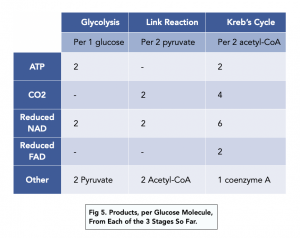Oxidative Phosphorylation and the Electron Transport Chain (A-level Biology)
Oxidative Phosphorylation and the Electron Transport Chain
Oxidative Phosphorylation

Oxidative phosphorylation involves the phosphorylation of ADP to form ATP. Oxygen is the electron acceptor (hence ‘oxidative’).
Oxidative phosphorylation consists of two steps:
- Electron transport chain (ETC) – this is a chain of electron carriers in the inner mitochondrial membrane. They use the electrons from reduced NAD and FAD, and move them along the ETC.
- Chemiosmosis – electrons release energy as they pass through the ETC. This energy is used to actively pump H+ from the mitochondrial matrix into the intermembrane space. The H+ then diffuses back out via ATP synthase, which drives ATP synthesis. The flow of H+ ions is called chemiosmosis.
Summary of Previous Steps
The following table summarises the products, per glucose molecule, from each of the 3 stages far:

NAD and FAD
- NAD and FAD have acted as electron acceptors in previous steps. During the various oxidation processes in glycolysis, link reaction, and the Krebs Cycle, electrons were lost. These electrons were accepted by NAD and FAD, which became reduced to form reduced NAD and reduced FAD, respectively.
- NAD and FAD transport the electrons to the inner mitochondrial membrane. NAD and FAD transport the electrons that they accepted to the inner mitochondrial membrane, where the electrons enter into the Electron Transport Chain (ETC).
Electron Transport Chain
The inner mitochondrial membrane has several proteins embedded within it, including:
- Electron carriers – several electron carriers which transport electrons along the membrane.
- Complexes I to IV – these four complexes are important for pumping H+ into the inter membrane space.





Still got a question? Leave a comment
Leave a comment